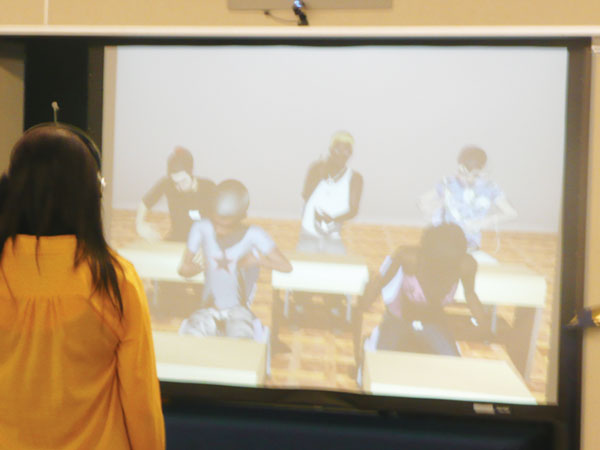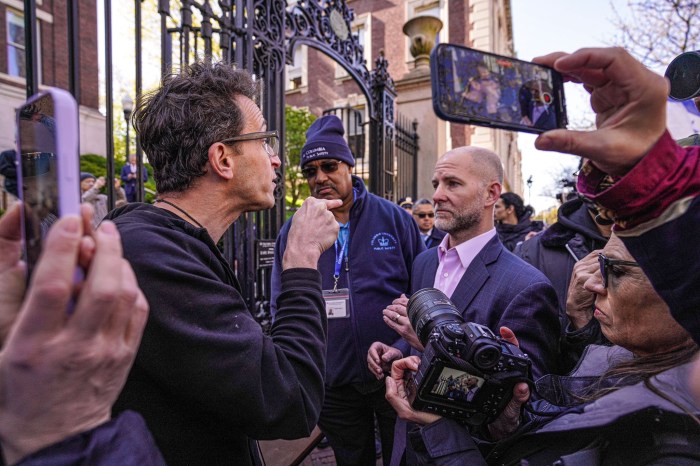 [/media-credit]
[/media-credit]
- The TeachLivE technology, developed to help future teachers learn to interact with students, was unveiled at Pace University last Wednesday.
BY MARSHALL JAMES KAVANAUGH | It was a scene out of science fiction. Trina Schattenkirk, a Pace University School of Education graduate and New York City Teaching Fellow, stood in front of a class of five animated students projected onto the wall. She wore a headset with headphones, a microphone, and an antenna with a small metal sphere projecting out the top. The device looked like something you would see in an episode of Star Trek.
The display in front of her followed Schattenkirk’s every motion, so when she stepped forward to the left, the projection zoomed in on the student in the back left corner of the classroom. When she stepped back, the camera zoomed out and again the virtual class was displayed.
Schattenkirk spoke as a teacher would speak to her class during their first week, introducing herself and asking the digital students to introduce themselves to each other through various exercises. The virtual students had lifelike and very thoughtful responses making it difficult to tell whether the whole performance was scripted or if this was some form of new artificial intelligence, at least 20 years ahead of its time.
This wasn’t at a conference for technological advancement, though.
It was at the ribbon-cutting ceremony held on Wednesday, Jan. 18 for a new technology that will be part of the spring semester curriculum for student teachers at the Pace University School of Education. The technology is called TeachLivE, with an emphasized “E” for education. It was developed at the University of Central Florida (UCF) about four years ago to help student teachers build their confidence before entering the classroom.
The software is much like a flight simulator for pilots. It gives the teacher a chance to practice creating a positive learning atmosphere with students of various personality types. They can even record their performance for later review with their instructor. The student teacher can learn from their mistakes and get used to a teaching style that works without the pressures of being put into a classroom with real life students for the first time.
“TeachLivE helps a student teacher learn how to build the classroom community and get students excited,” said Schattenkirk who teaches middle and high school students at the Henry Street School for International Studies.
This learning experience would hardly be possible without the virtual students called “avatars.” Some actions are automatic and part of the programming, such as laughter and other small disruptions, but a single paid screen-guild actor from UCF called an “interactor” controls the majority of the avatars’ actions. The interactor does everything from the simple task of mimicking a different voice for each avatar to the more difficult task of providing separate personalities with complete backstories. The instructor can customize the personalities and the behavior of each avatar. The virtual class that Schattenkirk worked with had a mild setting.
One avatar named Monique, for instance, was a very enthusiastic student. While Schattenkirk was speaking, Monique would persistently raise her hand with a question that was off topic from the current discussion. Instead of ignoring Monique’s hand, Schattenkirk talked to her specifically in a calm, relaxed manner reminding her to save her questions until the end of the instructions. Eventually, Monique was called on and allowed to ask her question.
Another avatar named Maria seemed shy but also delivered some of the more eloquent responses to the teacher’s questions. After recognizing Maria as this type of student, Schattenkirk made sure to call on this avatar more often since the avatar was less likely to respond to a discussion on her own.
TeachLivE is constantly evolving based on feedback; the simulation already is in its third generation. An adult avatar is also in production for student teachers to prepare for their first parent-teacher conferences. Pace University happens to be the only school in the northeast and one of only ten schools in the United States to use this technology. During the spring semester, ten Pace classes with a total of over 300 students are scheduled to use TeachLivE.
For the next generation of real-life students, TeachLivE may turn out to be quite groundbreaking, producing experienced teachers that are confident enough to take on any and every type of classroom.

















